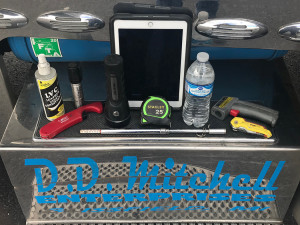 The dog days of summer are upon us again this year and along with them come the normal heat related problems. Not that long ago we were complaining about having to sling iron in the snow, but now it’s the bugs and too much sun. Sure is hard to satisfy a driver, these days. You can’t do anything about the weather, but you can prepare to ease the troubles that are caused by the heat. Preparation by its very definition means to do things in advance. Whether you do it yourself or if someone does it for you – it doesn’t matter, as long as it gets done.
The dog days of summer are upon us again this year and along with them come the normal heat related problems. Not that long ago we were complaining about having to sling iron in the snow, but now it’s the bugs and too much sun. Sure is hard to satisfy a driver, these days. You can’t do anything about the weather, but you can prepare to ease the troubles that are caused by the heat. Preparation by its very definition means to do things in advance. Whether you do it yourself or if someone does it for you – it doesn’t matter, as long as it gets done.
I can already see the gears turning in your head. Do I need to get my A/C charged again? No, wait, it’s already done – or is it? You’re not sure, are you? Check your Road Book and see when it was done last. What? You don’t have a Road Book! You’re not even sure what one is. Well, if you were trucking before the age of electronics, you would have carried a little black book that was full of information and numbers. My first one wasn’t black, it was red, and it wasn’t very little – it was about the size of a three-ring binder. We carried these books everywhere (they were an early version of the laptop we carry today).
All of our contact information was kept in the Road Book. We used them for dispatch, the phone numbers for brokers, their load numbers, expected weights of loads, desired temperature, pretty much anything associated with their freight. A lot of us kept maintenance records and expense information in there, too. Today, most of us carry enough electronic devices to take control of NASA. But, the 64-thousand-dollar question is: are you using those devices to your greatest advantage? Probably not.
I still use a spiral notebook for my state line mileages and fuel reporting. I find it much easier to write things down when I’m moving. I know we are not supposed to text and drive, but unless they want every truck that crosses the state line to stop, then we need to quickly mark the mileage in our books while moving. I keep service records in my Road Book, too, simply because they can’t get deleted and the batteries can’t go dead when I need information. Don’t misunderstand me – I use electronic storage, as well, but it’s too hard to access quickly when I’m rolling.
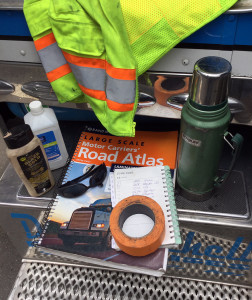 Those of you who read this article in 10-4 every month know that I like to address issues that impact the regular road driver. That includes all the local and route drivers, too. Once a driver leaves the terminal, they are responsible for the operation of the equipment, and also expected to maintain the safe and courteous transport of whatever they are carrying. That sounds simple enough, until something goes wrong. What do you do then, besides call dispatch? Do you have the ability to aid in the event of a service call or in the diagnosis of a possible problem?
Those of you who read this article in 10-4 every month know that I like to address issues that impact the regular road driver. That includes all the local and route drivers, too. Once a driver leaves the terminal, they are responsible for the operation of the equipment, and also expected to maintain the safe and courteous transport of whatever they are carrying. That sounds simple enough, until something goes wrong. What do you do then, besides call dispatch? Do you have the ability to aid in the event of a service call or in the diagnosis of a possible problem?
How many items do you carry that you haven’t realized are tools? I am aware that most companies don’t want drivers turning wrenches on their equipment, and I can appreciate their concern, but I’m not talking about hand tools or air wrenches. For the purpose of this article, let’s assume you’re riding over the mountain and you notice your water gauge on the dash reading higher than normal. Do you have any way to tell if you’re really overheating, other than the dash reading? If you carry a thermo scanner you do. Why would you have one and what is it used for? Many of us use them to check the temperature of our meat or produce, instead of using the traditional probe-style thermometer. Did I hear someone out there say they don’t run no “Chicken Truck” so they don’t need one? Not so, says I.
Getting back to that hot radiator, you could use a thermo scanner to check it and verify if the dash reading is true and correct or not (provided you know where to check). If you’re not sure, ask your shop manager or mechanic to show you in advance. All the tools in the world are useless if no one can operate them. Even if you don’t open the hood, you still need to check your tires, right? Oh, you didn’t know that can be done by scanning for temperatures, too?
If a tire is low on air pressure or has some other issue, it would have a different temperature then the rest. Obviously, this method only works when the tires have been in service and have some heat from rolling. The same goes for your brakes – if you check them and find one brake drum is colder than the rest, you know it’s out of adjustment. Just for the record, that is what DOT is doing when you roll across their scales. Did you ever notice the post on their driveway with a little box about 12 inches off the ground? You guessed it – that’s a scanner checking wheel end temps.
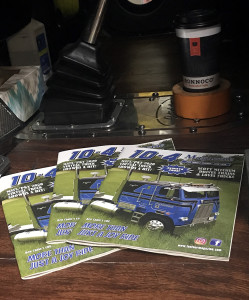 Let’s stay with tires for a minute. Do you carry a good tire gauge? Not one of those cheapies, but a good one that is dependable. Have you checked it against any other gauges to be sure? Do you know how much air pressure your tires should have? No, not all tires use the same amount of pressure. Once again, if you’re not sure, check with your maintenance shop. A good rule of thumb is most highway trucks use G rated tires and most of them recommend 110 psi (pounds per square inch) when cold.
Let’s stay with tires for a minute. Do you carry a good tire gauge? Not one of those cheapies, but a good one that is dependable. Have you checked it against any other gauges to be sure? Do you know how much air pressure your tires should have? No, not all tires use the same amount of pressure. Once again, if you’re not sure, check with your maintenance shop. A good rule of thumb is most highway trucks use G rated tires and most of them recommend 110 psi (pounds per square inch) when cold.
Some of the new drivers may not be familiar with how to tell what rating their truck tires are. So, look at the side of a tire and read the small print. It should say 14 ply or give a letter size with a weight rating. If by chance you have 16 ply tires, they will often call for 120 psi when cold. The ambient temp can affect tire life. Remember, when the temp goes up, so does your tire pressure. During the summer months, I tend to run a little less psi, which allows the tire to expand without causing damage. But, I still recommend you check with your shop or a tire dealer for the best advice for your application. Properly inflated tires can save you wasted time on the side of the road getting a repair.
How many of you are carrying duct tape or painter’s tape? If you drive a Peterbilt, I’m betting you do. I only say this because Peterbilts have a poor excuse for a cup holder and a full roll of tape works well at holding your coffee cup! After you spill enough coffee and soda, most of us get over the fact that it doesn’t look very sexy, but it works well all the same. I like the painter’s tape for a couple reasons: one, it’s cheaper than gorilla brand tape, and two, it is much easier to write on. I still like to have a roll of heavy duct tape for road repairs like holes in the roof of a van trailer or tears in someone’s tarp. Anyone doing multi-stop loads knows how easy it is to screw up your stops. I do lots of these loads, so I keep a broad tip marker in the door pouch because it works well to mark pallets, and the tape gives you something to write on that won’t mark up the customer’s freight.
These are cheap and easy ideas every driver can use to help make the day go better. This method of labeling your pallets is a good tool for all of us. I use it to keep track of service repairs, as well. How often do you notice a possible wear item on the truck that you need to fix? The repair may not be critical today, but it will need to be addressed in the near future. Then, you go off and forget about it until something breaks. Next time grab your pen and tape and make a “fix it flag” you can attach to it. If it isn’t something you can stick a flag on, then stick it to the inside of your bunk door. Either way, you should see it and be reminded of the necessity to make the repair as soon as possible.
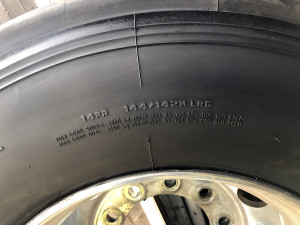 Does anyone besides me still carry a thermos? I sure hope so, if for no other reason than to carry your morning cup of Joe. If you’re not a coffee drinker or if you stop and pick up a fresh cup first thing each day doesn’t matter – every driver should still carry the faithful time tested and proven insulated vessel. What for, you ask? To carry clean hot water. That can become mighty helpful if you need to clean up after a trucking mishap. Lord only knows how many ways a driver can become injured on the job. A clean washcloth and hot water make for a restful night’s sleep if you can’t get back to civilization and you’re stuck out in the boonies. I also use mine to make ramen noodles or hot soup when I’m stuck at a dock or produce shed.
Does anyone besides me still carry a thermos? I sure hope so, if for no other reason than to carry your morning cup of Joe. If you’re not a coffee drinker or if you stop and pick up a fresh cup first thing each day doesn’t matter – every driver should still carry the faithful time tested and proven insulated vessel. What for, you ask? To carry clean hot water. That can become mighty helpful if you need to clean up after a trucking mishap. Lord only knows how many ways a driver can become injured on the job. A clean washcloth and hot water make for a restful night’s sleep if you can’t get back to civilization and you’re stuck out in the boonies. I also use mine to make ramen noodles or hot soup when I’m stuck at a dock or produce shed.
What truck driver worth their salt doesn’t have car wax and vinyl cleaner in the truck at all times? Almost all of us do. I won’t recommend any one brand of product, just the concept of what to use it on, and then I would expect you to experiment and see what works best for you. A few of you may be scratching your heads wondering why I need to tell someone how to use wax and polishes. I’m not going to tell you how, but rather where to use these products.
When you get the truck washed most places will offer Rain-X as an option, right? Did you ever wonder how they got the idea to mix wax with water and spray it on the windows? I’ve used a product from California Custom called LVC (Leather Vinyl Cleaner) for years. I apply it on the inside of the windows and mirror glass. Wipe it on and let it dry, then buff it off (easy peasy). It’s cheap and helps to keep bugs from sticking to the glass. Plus, the rain tends to bead off much faster and gives better visibility during inclement weather.
Before you spray any old cleaner all over the place, first check on a small out-of-the-way place to make sure your cleaner will dry and not leave a greasy mess. Many operators prefer to use car wax instead. I’ve used both and find it’s just a personal preference. A good place to test this is at home in the shower or on the bathroom mirror. If you find this doesn’t work for you, then grab your handy dandy Covid-19 spray repellent. I keep isopropyl alcohol in the truck for that. It is also an excellent window cleaner for those of you who smoke.
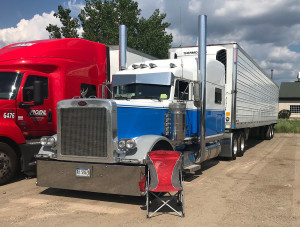 I would be remiss not to mention some safety items here, too. The most important safety product I have ever found is a professional truck driver’s atlas. Not your run of the mill GPS! That will only tell you how to get somewhere, not where that place is in relation to everything around it. Your GPS doesn’t always know if the route it recommends is weight or size compliant. Look at how often we see news reports of trucks on fire trails and places they should have never been. I’m a firm believer there is no excuse for bad judgment.
I would be remiss not to mention some safety items here, too. The most important safety product I have ever found is a professional truck driver’s atlas. Not your run of the mill GPS! That will only tell you how to get somewhere, not where that place is in relation to everything around it. Your GPS doesn’t always know if the route it recommends is weight or size compliant. Look at how often we see news reports of trucks on fire trails and places they should have never been. I’m a firm believer there is no excuse for bad judgment.
When I first leased on to a large carrier, they forced us to sit through hours of map training. I think they called it Pre-Trip Preparation. Fortunately, I have also had early training in the military on reading topography or the land surface. This is essential for those of us running across the country on non-regular routes. Even though I have been doing this for years, I still look at my atlas for reference when there is a weather change or if I need to find an alternative route.
For those of us who hit the two lanes, it’s not possible to memorize all the detours or construction projects we might encounter. I seldom start any load that I don’t first check the weather map and then choose the best route from there. This is the season for tornadoes and bad storms. That GPS may save you 50 miles, but if your truck gets destroyed by softball-sized hail, I’m not sure it was your best option. Even if you don’t encounter bad weather, how often do you run into the trail of orange barrels and the lane restrictions they cause?
Speaking of construction projects and such, I have on occasion needed help blocking traffic or stopping the flow of cars when maneuvering tight spots. Do you carry an extra safety vest for your helper? A shipper or receiver will often send out some employee to assist me in backing to the dock. I throw them the vest or a flag to stop traffic. Better to be safe than sorry. When was the last time you came onto an accident scene and needed to assist law enforcement? You do know that’s part of our job – to protect the motoring public. Helping a police officer isn’t just an old school thing to do, it’s the right thing to do.
I’ve waited until the end for the opportunity to bring up the mention of smart thinking. That’s right – we have the ability to think for ourselves and to make informed decisions. This is by far the most powerful tool we as drivers have. There is no difference between owner operators and company drivers. If you think something is off or not functioning correctly, it’s up to you to investigate. The power of reason is what separates us from the animal world (along with our two thumbs, which help us to hold the steering wheel).
Now that summer is full on and the heat is wreaking havoc with most of us, don’t lose your cool or your sense of responsibility. Remember, we as the truck driver are the lifeline between the shipper and their customer. How we handle any given situation can mean the difference between our success and them going out of business.
In your spare time, while you are sitting around waiting on someone to make a decision, take an inventory of your tools. I’m sure there are more than just the ones I listed here (I never even mentioned my world-famous red lawn chair or the blue bucket I carry). I will save those secrets for another time, as there could be an entire article on just those two things. If you are still curious about them and you see me on the road, ask me and I will tell you another story. Until then, keep “tooling along” – I will be watching for you, 10-4.
